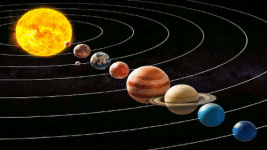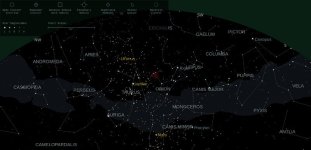Gwolf
Well-known member
From now until the end of February there will be a planetary alignment.
This is when all or most of the planets will be lined up in a row. I saw the beginning of it last night. Just after dark 30 go outside and look about 20 degrees to the South of due West. The alignment will be the brightest thing in the night sky. It it is visible just above the Western horizon from where I am located. It might be higher up or lower in the sky, depending on what latitude you are looking at it from. Also, if you live in a city, the light pollution there will make it much more difficult to see. There is almost no light pollution where I live,o and the beginning of the alignment was shining very bright.

If you are familiar with the night sky, then you will know that you can't see all the planets that are aligned, because you are looking from the Earth (3rd planet from the Sun!) So Mercury and Venus will be on the side facing toward the Sun, and the other planets will be on the side looking away from the Sun. There will not be another major alignment until the year 2040, so don't miss this one if the sky is clear enough to see it. Weather, clouds, and fog can block the view, but the planets are much closer than the stars, and the light of the Sun reflecting from them will be almost as bright as the Moon, but they are farther away, so the bright spots of light are smaller than the Moon.
Here is a website with most of the information you will need to locate the planets in the night sky, and the best times to see them.
https://starwalk.space/en/news/what-is-planet-parade
This is when all or most of the planets will be lined up in a row. I saw the beginning of it last night. Just after dark 30 go outside and look about 20 degrees to the South of due West. The alignment will be the brightest thing in the night sky. It it is visible just above the Western horizon from where I am located. It might be higher up or lower in the sky, depending on what latitude you are looking at it from. Also, if you live in a city, the light pollution there will make it much more difficult to see. There is almost no light pollution where I live,o and the beginning of the alignment was shining very bright.

If you are familiar with the night sky, then you will know that you can't see all the planets that are aligned, because you are looking from the Earth (3rd planet from the Sun!) So Mercury and Venus will be on the side facing toward the Sun, and the other planets will be on the side looking away from the Sun. There will not be another major alignment until the year 2040, so don't miss this one if the sky is clear enough to see it. Weather, clouds, and fog can block the view, but the planets are much closer than the stars, and the light of the Sun reflecting from them will be almost as bright as the Moon, but they are farther away, so the bright spots of light are smaller than the Moon.
Here is a website with most of the information you will need to locate the planets in the night sky, and the best times to see them.
https://starwalk.space/en/news/what-is-planet-parade
Last edited:

